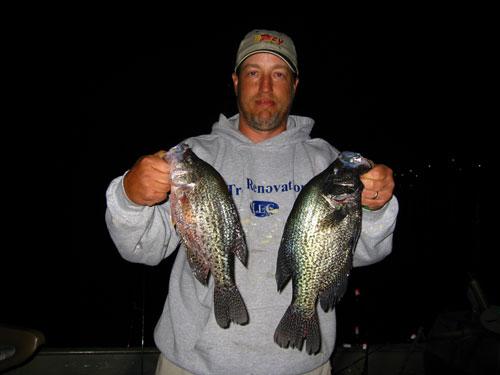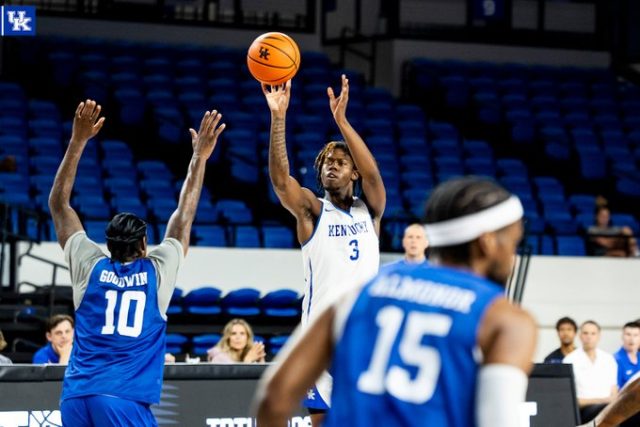Kentucky Afield Outdoors: Anglers must change with the times to catch more crappie at Kentucky Lake
Published 12:00 am Monday, June 7, 2010

- Garrard County's Greg Carter holds two hefty black crappie taken recently from Kentucky Lake. The numbers of 10-inch and larger crappie are at an all-time high on Kentucky Lake, but they are black crappie, not white crappie. Black crappie require different presentations and techniques to successfully catch than white crappie.
If you played golf or dug a posthole back in the late 1980s, one thing sticks in your mind: the ground was as hard as cured concrete.
You felt like a superstar off the golf tee as your ball rolled 50 yards past your usual drive on the cracked, hard ground. You could easily break the handle of your posthole digger by attempting to pierce the ground.
Trending
“The 1980s were the driest 10-year period in the history of the region,” said Gerry Buynak, assistant director of fisheries for the Kentucky Department of Fish and Wildlife Resources. “Below normal rainfall also occurred in three of the first four years of the 1990s. The severe droughts that happened every year for 13 years in a row caused low flows and major changes in water clarity, fish abundance and productivity in Kentucky and Barkley lakes.”
The lower flows cleared the water and prompted an explosion in aquatic plants at Kentucky Lake. “You need sunlight and clear water to grow aquatic plants,” Buynak said. “Improved agricultural practices also helped clear the water and water quality and fish production vastly improved in both lakes as a result.”
The transformation of the lake’s water quality and production benefitted species such as largemouth bass, smallmouth bass, redear sunfish and black crappie. These lakes also saw major increases in numbers of forage species, such as shad, and in the total amount of all of the fish in the lake.
“White crappie, white bass and sauger were several of the species that did not like the change,” Buynak explained. “Around 1996, the black crappie population overtook the population of white crappie and they’ve expanded their dominance since then.”
Anglers accustomed to fishing with traditional white crappie tactics grew more frustrated with each passing year.
“The old days of spider-rigging or sitting on a ledge won’t be as effective as they used to be,” Buynak said. “The black crappie currently are an underutilized resource, but they have different habitat preferences than white crappie.”
Trending
White crappie prefer stained to muddy water in spring for spawning. Black crappie prefer clearer water and aquatic vegetation to reproduce. Black crappie reproduce better in the clearer, weedy water than white crappie.
“We can’t control the environmental factors,” said Jeff Ross, assistant director of fisheries for Kentucky Fish and Wildlife. “We manage the fish to try to overcome any negative effects of environmental factors. But if those factors are too strong, our management gets overwhelmed. Mother Nature usually has the final say.”
While some anglers may pine for the good old days of white crappie fishing, many don’t realize the good old days for keeper-sized crappie – fish 10 inches and longer – are right now.
“The years 2008 and 2009 are our best years ever for crappie over 10 inches long in Kentucky Lake, but most of them are black crappie,” Buynak said. “The best year ever for white crappie was in 1987, when we had about four white crappie over 10 inches per net. In 2009, we had a little over 10 black crappie over 10 inches per net.”
The same trends are occurring in the Tennessee section of Kentucky Lake, as studies show nearly 2½ times the number of keeper-sized black crappie than white crappie. Even though population sampling shows that black crappie are now the dominate species in both sections of Kentucky Lake, the Kentucky portion holds substantially more black crappie than the Tennessee portion. The Kentucky section has more than four times more keeper black crappie than the Tennessee waters of the lake.
While both black and white crappie strains are still technically crappie, the techniques used to catch them are as different as those used for largemouth and smallmouth bass.
Black crappie move shallow much earlier than white crappie, often during the first weeks of March. They stay shallow until summer.
Black crappie behave like smallmouth bass in their habits. They suspend in the water column over brush, downed trees and pea gravel banks, depending on the time of year.
In early spring, black crappie suspend over downed trees along the bank that extend out into deep water on the east side of Kentucky Lake and in the major bays of the west side such as Blood River. Toss a chartreuse, pink, white or lime-green grub or feather jig into these trees and pick off the black crappie.
As the water warms into April, target pea gravel banks near deep water. Black crappie suspend over these banks. Throw a 1/16 -to 1/8-ounce leadhead grub toward these banks and begin reeling as soon as the lure hits the water. If this doesn’t produce a strike, wait two seconds before reeling and so on until you find the holding depth of the black crappie that day.
This open water style of fishing is the hardest adjustment white crappie anglers must make to successfully catch black crappie. Once you catch a black crappie, your confidence will grow.
Homeowners on Kentucky Lake’s shoreline often sink brush, old Christmas trees and tree branches felled by storms near their boat docks. Casting a grub or feather jig and retrieving the lure just above this cover produces black crappie.
Anglers must make long casts to avoid spooking black crappie. A boat that drifts over a pod of black crappie will send those fish to the depths. They often hit well away from the boat or bank. Avoid making loud noises in the boat. Don’t violently shake your lure if you get hung in brush. Black crappie nearby will skedaddle.
White crappie tolerate boats above them; they also will remain in shallow water even if there are anglers nearby. Anglers accustomed to fishing for white crappie must be stealthy when chasing black crappie.
The dominance of black crappie may continue for many years. “We stocked white crappie in the Blood River portion of Kentucky Lake and the Little River section of Lake Barkley,” Ross explained. “We haven’t given up on white crappie, but we would need 10 or 12 years of spring flooding to reverse these trends.”
The changes in the lake also profit bass anglers. From 1978 to 1982, Kentucky Lake averaged slightly less than 10 pounds per acre of largemouth bass. By 1990, the productivity of Kentucky Lake produced 45 pounds per acre of largemouth bass.
On Lake Barkley in 1978, population sampling revealed a little over 4.5 pounds per acre of largemouth bass. By 1990, that number increased to 50 pounds per acre.
The largemouth bass populations on both lakes are in excellent shape with many 14- to 18-inch fish. Many of these fish will surpass 4 pounds in the coming years.
Clear your mind and change tactics to get on these black crappie. They will remain shallow and available to your lures well into June. The good old days of crappie fishing on Kentucky Lake aren’t behind us. The good old days are right now.
Author Lee McClellan is an award-winning associate editor for Kentucky Afield magazine, the official publication of the Kentucky Department of Fish and Wildlife Resources. He is a life-long hunter and angler, with a passion for smallmouth bass fishing.
The Kentucky Department of Fish and Wildlife Resources manages, regulates, enforces and promotes responsible use of all fish and wildlife species, their habitats, public wildlife areas and waterways for the benefit of those resources and for public enjoyment. Kentucky Fish and Wildlife is an agency of the Tourism, Arts and Heritage Cabinet. For more information on the department, visit our Web site at fw.ky.gov.







